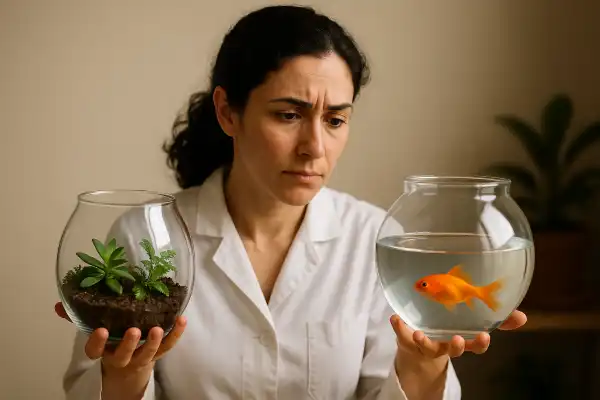Can you put fish in a terrarium? This question pops up frequently among enthusiasts who are drawn to the miniature world-building aspect of both aquariums and terrariums. The appeal is understandable—imagine combining the serene beauty of watching fish swim with the lush, tropical landscapes that terrariums create.
Many people ask this question because they’ve seen stunning displays that appear to combine fish and terrestrial plants in the same container. These captivating setups often showcase waterfalls, moss-covered rocks, and small fish swimming below—but the truth about what you’re actually looking at might surprise you.
Can you put fish in a terrarium?
A terrarium (terra = land) is an enclosure for a land habitat for animals, plants, fungi, lichens or any combination thereof. The simple answer is no—fish cannot live in a traditional terrarium. Terrariums are specifically designed as terrestrial environments, meaning they’re built for land-based ecosystems, not aquatic life.
The confusion often stems from seeing mixed land-and-water displays that look like terrariums but are actually something entirely different. Understanding the distinctions between different types of containers will help clarify why fish and terrariums don’t mix, and what alternatives exist for those dreaming of underwater gardens.

Understanding what makes a terrarium
Traditional terrariums are enclosed or semi-enclosed containers designed to create self-sustaining mini-ecosystems for terrestrial plants and land animals. The finished product is beautiful, and once established, caring for a DIY fish tank terrarium requires very little effort. These environments focus on soil layers, drainage systems, and moisture control through humidity rather than standing water.
In terrariums, there may be a bowl of water or something similar so the animal can stay hydrated. However, it will be very small and not take up the majority of the tank. Even when terrariums include small water features, these are typically shallow dishes meant for drinking water or ambient humidity, not swimming spaces for fish.
The substrate layers in terrariums serve specific functions: drainage gravels prevent root rot, activated charcoal filters air quality, and specialized soil mixes support plant growth. None of these components create the deep, filtered water environment that fish require to survive.
Why fish need aquatic environments
Fish have evolved for life underwater and require specific conditions that terrariums simply cannot provide. They need substantial water depth for swimming, proper dissolved oxygen levels, temperature regulation, and biological filtration systems to process waste products.
Invertebrates don’t require as much dissolved oxygen in the water as vertebrates like fish, so it’s not necessary. This biological reality means that even if you tried to add more water to a terrarium setup, the environment still wouldn’t support fish life properly.
Fish also produce ammonia through their waste, which must be processed by beneficial bacteria in established filtration systems. You must have some type of healthy bacteria circulating in the tank before you can sustain healthy aquatic life. Terrariums lack these crucial biological filtration systems that keep aquatic environments healthy for fish.
The paludarium solution
What many people are actually envisioning when they ask about fish in terrariums is called a paludarium. A paludarium is a type of vivarium that incorporates both terrestrial and aquatic elements. These semi-aquatic environments successfully combine land and water areas within the same container.
As a modern fusion of terrestrial and aquatic elements, paludariums have the potential for some seriously stunning scenes. Paludariums feature substantial water sections that can house fish alongside terrestrial areas for land plants and potentially semi-aquatic animals like frogs or salamanders.
The key difference lies in the design: while terrariums prioritize land environments with minimal water, paludariums are intentionally built to support both aquatic and terrestrial life zones. A paludarium combines the best of two worlds: an extra deep bottom allows you to incorporate a substantial water part or aquarium section adjacent to the land or terrarium section.
Setting up a fish-friendly paludarium
Creating a paludarium that can house fish requires careful planning and appropriate equipment. The aquatic portion needs proper filtration, adequate water depth, and cycling before introducing any fish. Popular fish choices include assorted killifish, cichlids, angelfish, mollies, danios, gouramis, common mollies, guppies, and others.
The technical requirements include installing aquarium-grade filtration systems, ensuring proper water circulation, and maintaining appropriate temperature controls. The technical equipment needed for a paludarium is quite similar to that of an aquarium, for example the filtration and the lights. Additionally, lighting systems must accommodate both aquatic and terrestrial zones.
When selecting fish for paludariums, choose species that prefer similar water parameters and can coexist peacefully. Make sure they like a similar range of Ph and temperature. If it’s a community tank, make sure none of the fish are territorial towards other fish. Smaller, peaceful species often work best in these mixed environments.
Alternative approaches for aquatic displays
For those interested in aquatic plant displays without fish, ripariums offer another compelling option. A riparium (ripa = bank or shore) is a semi-aquatic enclosure with a land area beside a water area. These setups focus on recreating shoreline environments and can feature stunning aquatic plant arrangements.
Converting an existing aquarium into a terrarium presents another avenue for exploration. Plant terrariums need a lot less maintenance than fish aquariums, so we might as well put them to use! This approach allows you to repurpose aquarium equipment while creating beautiful terrestrial displays.
Aquascaping in traditional aquariums can also satisfy the desire for underwater gardens. A Dutch aquarium (origin = Netherlands) is an underwater garden that features plants, with minimal visible hardscaping and few fish. These planted aquarium styles prioritize lush underwater plant growth over fish populations.
Conclusion
Understanding the fundamental differences between terrariums and aquatic environments helps explain why fish and terrariums aren’t compatible. However, paludariums offer an exciting alternative that captures the best of both worlds—allowing fish to thrive alongside terrestrial plants in carefully designed semi-aquatic ecosystems.
Just last month, I helped a client transition her failed terrarium-fish experiment into a stunning paludarium featuring neon tetras swimming beneath a canopy of climbing ficus and air plants. The transformation reminded me why understanding these distinctions matters—it’s the difference between frustration and creating a thriving miniature world that brings daily joy. Through my years of building hundreds of these enclosed ecosystems, I’ve learned that respecting the specific needs of each environment ultimately leads to the most successful and beautiful results.
